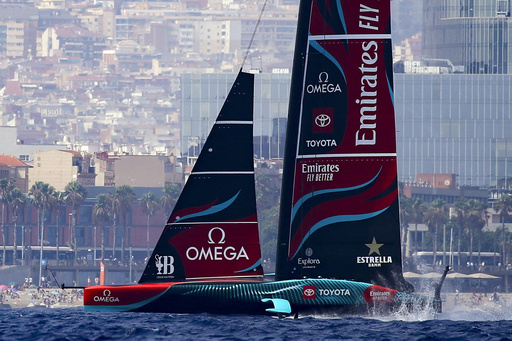BARCELONA, Spain — As the highly anticipated America’s Cup finals kick off this Saturday, Geoff Willis will be amongst numerous designers and analysts anxiously monitoring the matches from the shore. Concentrated at his computer in Barcelona’s historic port, he keenly observes the movements of the Britannia yacht, finding the experience quite nerve-wracking. This is noteworthy for a professional with three decades of experience in Formula 1 racing, showcasing the intensity of the situation.
Willis is at the helm of the design collaboration between INEOS Britannia and the Mercedes F1 team, a partnership that began in 2019 and has fully integrated for this particular cup campaign. This sailing syndicate, backed by billionaire Jim Ratcliffe, is aiming to secure Britain’s first-ever victory in the 173-year history of the prestigious regatta. “Considering our country’s track record in the cup, achieving this would be incredibly special,” mentions Willis.
The partnership has shown promising results so far, with Britannia outperforming five competitors through a consistent display of speed across varying wind conditions on the Barcelona coast, ranging from under 6 knots to 23 knots. Last week, the yacht set a remarkable America’s Cup record with a top speed of 55.6 knots (64 mph/102 kph), marking a significant achievement as it prepares for its first final appearance in sixty years. The team is now set to challenge the reigning champion, Emirates Team New Zealand, in a series where the first to achieve seven wins will be crowned victor.
The convergence of car racing and yachting is quite evident, as the current generation of America’s Cup foiling yachts spends a considerable amount of time above water instead of slicing through it. This transition has made aerodynamics a crucial aspect, an area where Formula 1 excels. “There is a remarkable overlap in technology between the Cup and Formula 1,” explains Willis. “The principles of hulls and sails in sailing relate closely to those of engines and tires in racing, with only about 10% of it being different. This significant overlap allows a Formula 1 team to contribute immensely to the entire program.”
After each race, Willis and his team — divided between Barcelona and their shared base in Brackley, England — meticulously analyze the data gathered from the thousands of sensors aboard the yacht. They aim to identify key insights that can assist skipper Ben Ainslie and his crew in improving performance. Willis emphasizes refining the “choreography” of operating the yacht effectively, regardless of whether they are sailing upwind or downwind amidst varying gusts.
There are, however, notable distinctions from Formula 1: communication with the yacht ceases three minutes prior to the start of the race, and the data analysis team must persuade not one, but eight crew members of their findings. Also, the unpredictability of the open sea adds another layer of complexity. “The technical risks in the Cup are significantly higher than in F1,” Willis states. “There’s always the chance that the boat could hit a wave at the most inconvenient time, making this much more intense than watching a Formula 1 race.”
On the other hand, New Zealand has opted to retain its design work in-house, which works well for their technical director, Dan Bernasconi. His dedicated team of approximately 40 engineers and designers has pioneered several groundbreaking innovations in sailing, including the development of the AC75 monohull which reshaped the competition during the 2021 event in Auckland and has undergone modifications for Barcelona.
“I firmly believe in our approach,” states Bernasconi. “We’ve maintained a stable team for over a decade, everyone understands their roles, and we interact exceptionally well. This cohesion holds significant value compared to the narrowly focused objectives an F1 team might present. We shall soon see how it plays out.”
Another unique element of the America’s Cup format is that New Zealand, as the defending champion, automatically qualifies for the finals, having participated initially but not counting those races. This advantage has granted them a month of dedicated practice, allowing them to refine their approach while observing the competitors.
Thus, Bernasconi’s team has access to a wealth of recent racing data from Britannia’s challenger series. This advantage is critical in executing last-minute engineering adjustments and influencing tactical decisions made by coaches and skippers. “If we determine we’re consistently 10% slower across the course, the strategy must become high stakes at the start; if we are behind, our chances significantly diminish,” Bernasconi explains. “Conversely, knowing we’re ahead could lead to a more cautious approach at the start to minimize risk.”


